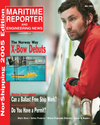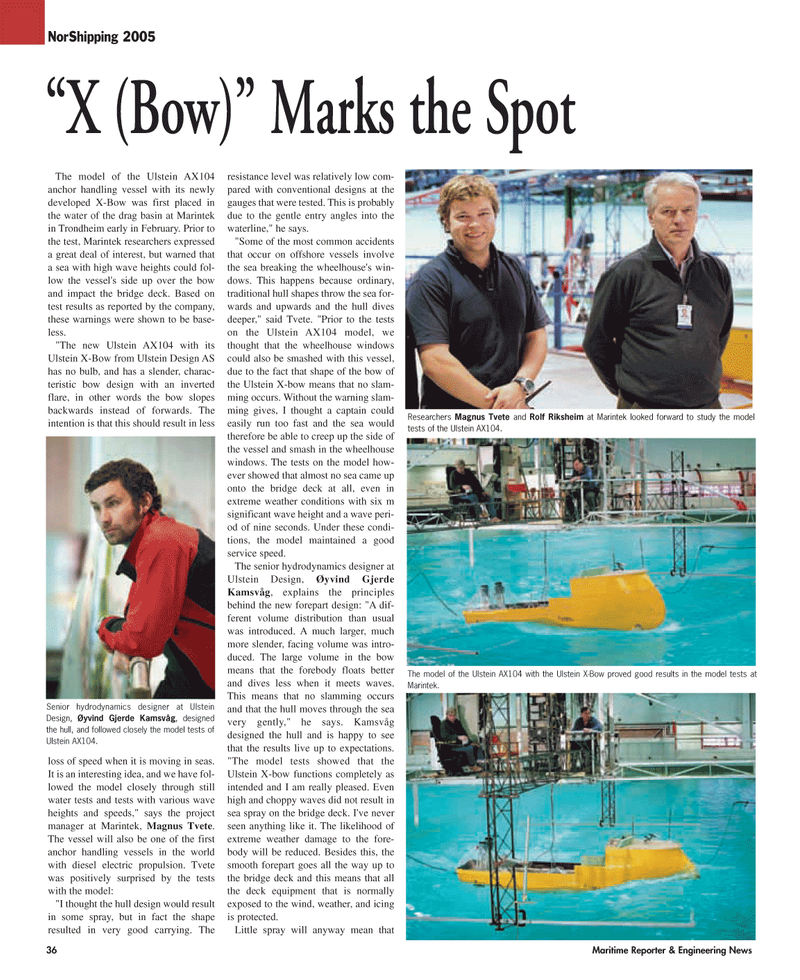
Page 36: of Maritime Reporter Magazine (May 2005)
Marine Enviroment Edition
Read this page in Pdf, Flash or Html5 edition of May 2005 Maritime Reporter Magazine
The model of the Ulstein AX104 anchor handling vessel with its newly developed X-Bow was first placed in the water of the drag basin at Marintek in Trondheim early in February. Prior to the test, Marintek researchers expressed a great deal of interest, but warned that a sea with high wave heights could fol- low the vessel's side up over the bow and impact the bridge deck. Based on test results as reported by the company, these warnings were shown to be base- less. "The new Ulstein AX104 with its
Ulstein X-Bow from Ulstein Design AS has no bulb, and has a slender, charac- teristic bow design with an inverted flare, in other words the bow slopes backwards instead of forwards. The intention is that this should result in less loss of speed when it is moving in seas.
It is an interesting idea, and we have fol- lowed the model closely through still water tests and tests with various wave heights and speeds," says the project manager at Marintek, Magnus Tvete.
The vessel will also be one of the first anchor handling vessels in the world with diesel electric propulsion. Tvete was positively surprised by the tests with the model: "I thought the hull design would result in some spray, but in fact the shape resulted in very good carrying. The resistance level was relatively low com- pared with conventional designs at the gauges that were tested. This is probably due to the gentle entry angles into the waterline," he says. "Some of the most common accidents that occur on offshore vessels involve the sea breaking the wheelhouse's win- dows. This happens because ordinary, traditional hull shapes throw the sea for- wards and upwards and the hull dives deeper," said Tvete. "Prior to the tests on the Ulstein AX104 model, we thought that the wheelhouse windows could also be smashed with this vessel, due to the fact that shape of the bow of the Ulstein X-bow means that no slam- ming occurs. Without the warning slam- ming gives, I thought a captain could easily run too fast and the sea would therefore be able to creep up the side of the vessel and smash in the wheelhouse windows. The tests on the model how- ever showed that almost no sea came up onto the bridge deck at all, even in extreme weather conditions with six m significant wave height and a wave peri- od of nine seconds. Under these condi- tions, the model maintained a good service speed.
The senior hydrodynamics designer at
Ulstein Design, Øyvind Gjerde
Kamsvåg, explains the principles behind the new forepart design: "A dif- ferent volume distribution than usual was introduced. A much larger, much more slender, facing volume was intro- duced. The large volume in the bow means that the forebody floats better and dives less when it meets waves.
This means that no slamming occurs and that the hull moves through the sea very gently," he says. Kamsvåg designed the hull and is happy to see that the results live up to expectations. "The model tests showed that the
Ulstein X-bow functions completely as intended and I am really pleased. Even high and choppy waves did not result in sea spray on the bridge deck. I've never seen anything like it. The likelihood of extreme weather damage to the fore- body will be reduced. Besides this, the smooth forepart goes all the way up to the bridge deck and this means that all the deck equipment that is normally exposed to the wind, weather, and icing is protected.
Little spray will anyway mean that
NorShipping 2005 “X (Bow)” Marks the Spot
The model of the Ulstein AX104 with the Ulstein X-Bow proved good results in the model tests at
Marintek.
Researchers Magnus Tvete and Rolf Riksheim at Marintek looked forward to study the model tests of the Ulstein AX104.
Senior hydrodynamics designer at Ulstein
Design, Øyvind Gjerde Kamsvåg, designed the hull, and followed closely the model tests of
Ulstein AX104. 36 Maritime Reporter & Engineering News
MR MAY 2005 #5 (33-40).qxd 5/2/2005 9:10 PM Page 36

 35
35

 37
37
